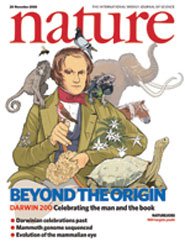美国科学家日前通过一团猛犸象的毛发,成功破译出这个史前庞然大物80%的基因组。尽管这是一团毫无光泽的毛发,却使科学家在复活猛犸象的道路上又向前迈进了一步。
科学家通过已在西伯利亚永久冻结带冷冻数千年的猛犸象尸体提取的毛发样本,整理出这种史前巨兽的DNA。基因代码让科学家对猛犸象的进化过程有了新的了解,同时表明它们远比之前想象的更接近于现代象。这项发现还可以使研究人员搞清楚大象的遗传构造,复活灭绝已久的猛犸象。

科学家利用从西伯利亚永久冻结带发现的两具猛犸象残骸上获取的DNA,实施了这种类似于科幻大片《侏罗纪公园》剧情的研究。美国科学家在最新一期科学杂志《自然》(Nature)上报告称,在这两具猛犸象尸体中,一具已在地下埋了2万年,另一具则至少埋了6万年。通过仔细分析它们的DNA,研究小组已经整理出80%的猛犸象基因组或遗传密码。
这项研究表明,两头猛犸象关系十分紧密。另外分析还表明,600万年前,猛犸象和现代象走向了不同的进化路径,几乎与此同时,人类和黑猩猩也走上了与它们一样的进化道路。200万年前,猛犸象一分为二,一组在距今4.5万年前灭绝,另一组在距今1万年前最后一个冰河时期的末期从地球上消失。
雄性猛犸象高约10英尺(约合3米),雌性相对矮一些。它们的尖牙长而弯曲,腹部的毛发最长可达3英尺(约合0.9米)。迄今,科学家已在西伯利亚发现了大约40具猛犸象的尸体。实施最新研究的美国科学家之所以使用提取自猛犸象毛发的DNA,是因为相对于猛犸象尸体其他部位的DNA,它们保存得更为完好。
一些研究人员一直建议使用冰冻猛犸象尸体的皮肤或毛发克隆猛犸象。领导这项研究的宾夕法尼亚州立大学教授史蒂芬·舒斯特(Stephan Schuster)说:“从理论上讲,通过破译这个基因组,我们可以获取重要的信息,将来有一天,只要将独特的猛犸象DNA序列融入现代象的基因组中,这些信息或能帮助其他研究人员复活猛犸象。”
但是,西澳大利亚默多克大学古生物DNA实验室主任迈克尔·邦斯(Michael Bunce)博士给舒斯特教授泼了一瓢凉水。他说:“掌握某种生物的DNA代码并不意味着我们可以通过遗传手段实现重造灭绝生物体的美好愿望。”(生物谷Bioon.com)

生物谷推荐原始出处:
Nature,456, 387-390,Webb Miller,Stephan C. Schuster
Sequencing the nuclear genome of the extinct woolly mammoth
Webb Miller1, Daniela I. Drautz1, Aakrosh Ratan1, Barbara Pusey1, Ji Qi1, Arthur M. Lesk1, Lynn P. Tomsho1, Michael D. Packard1, Fangqing Zhao1, Andrei Sher2,9, Alexei Tikhonov3, Brian Raney4, Nick Patterson5, Kerstin Lindblad-Toh5, Eric S. Lander5, James R. Knight6, Gerard P. Irzyk6, Karin M. Fredrikson7, Timothy T. Harkins7, Sharon Sheridan7, Tom Pringle8 & Stephan C. Schuster1
1 Pennsylvania State University, Center for Comparative Genomics and Bioinformatics, 310 Wartik Building, University Park, Pennsylvania 16802, USA
2 Severtsov Institute of Ecology and Evolution, Russian Academy of Sciences, 33 Leninsky Prospect, 119071 Moscow, Russia
3 Zoological Institute, Russian Academy of Sciences, Universitetskaya Naberezhnaya 1, 199034 Saint Petersburg, Russia
4 Center for Biomolecular Science and Engineering, University of California, Santa Cruz, California 95064, USA
5 Broad Institute of MIT and Harvard, 7 Cambridge Center, Cambridge, Massachusetts 02142, USA
6 454 Life Sciences, 20 Commercial Street, Branford, Connecticut 06405, USA
7 Roche Diagnostics Corporation, 9115 Hague Road, Indianapolis, Indiana 46250-0414, USA
8 Sperling Foundation, Eugene, Oregon 97405, USA
In 1994, two independent groups extracted DNA from several Pleistocene epoch mammoths and noted differences among individual specimens1, 2. Subsequently, DNA sequences have been published for a number of extinct species. However, such ancient DNA is often fragmented and damaged3, and studies to date have typically focused on short mitochondrial sequences, never yielding more than a fraction of a per cent of any nuclear genome. Here we describe 4.17 billion bases (Gb) of sequence from several mammoth specimens, 3.3 billion (80%) of which are from the woolly mammoth (Mammuthus primigenius) genome and thus comprise an extensive set of genome-wide sequence from an extinct species. Our data support earlier reports4 that elephantid genomes exceed 4 Gb. The estimated divergence rate between mammoth and African elephant is half of that between human and chimpanzee. The observed number of nucleotide differences between two particular mammoths was approximately one-eighth of that between one of them and the African elephant, corresponding to a separation between the mammoths of 1.5–2.0 Myr. The estimated probability that orthologous elephant and mammoth amino acids differ is 0.002, corresponding to about one residue per protein. Differences were discovered between mammoth and African elephant in amino-acid positions that are otherwise invariant over several billion years of combined mammalian evolution. This study shows that nuclear genome sequencing of extinct species can reveal population differences not evident from the fossil record, and perhaps even discover genetic factors that affect extinction.



